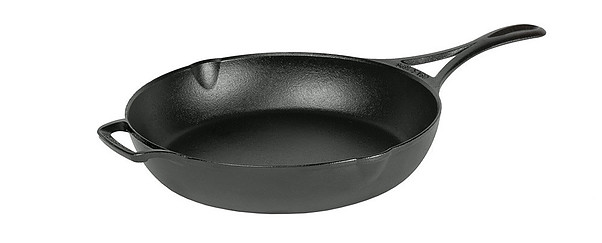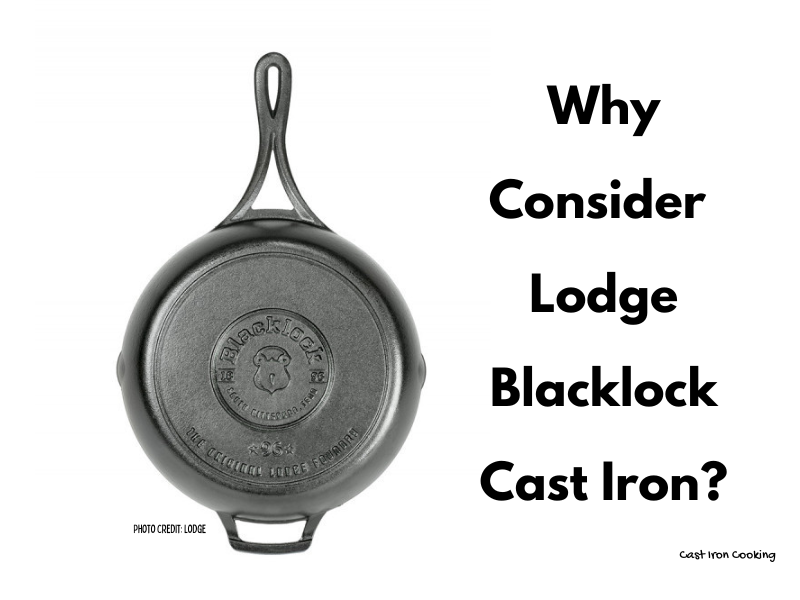You’ve most likely heard of Lodge Cast Iron. It’s the most well-known manufacturer for its quality cast iron and affordability.
However, several new cast iron companies have begun in recent years. Many of them focus on making cast iron the way it was made in the past. They aren’t trying to compete with Lodge; they are re-introducing the craftsmanship that went into making cast iron before automation and pre-seasoning.
Automation is a wonderful thing, for it allowed Lodge and other manufacturers to keep up with the high product demand. But it left behind a smaller market of those seeking smoother, lighter cast iron at a higher cost.
Cast iron took a hit when Teflon made its debut in the 1970s. Some of the companies still in business at the time didn’t survive. However, Lodge did. How they made it is a subject for another article.
While there is some debate over whether Lodge ever machined their cast iron, it’s a fact that it used to be cast thinner and weigh less.
So whether as a way of competing with these new cast iron brands or Lodge was simply being innovative (which they are), Blacklock was born.
Blacklock is Lodge’s premier line of cast iron.
So, why should you consider Lodge Blacklock cast iron?
Because it’s from a reputable company, and it has some features you might like and can’t get from their classic cookware.
However, ask yourself the following five questions first.
Table of Contents
Why Consider Lodge Blacklock Cast Iron?
When Lodge began in 1896, it was called Blacklock Foundry. To commemorate their history, Lodge released a new line of premier cast iron cookware in 2019. They called it Blacklock. Each piece of Blacklock links to an important date in Lodge history. Additionally, Blacklock offers triple seasoning (instead of the single standard layer) for a better nonstick finish. And a new proprietary blend of iron allows Lodge to cast the Blacklock thinner, making it lighter. Plus, the extended, raised handle stays cool longer.
1. Does Triple Seasoning Make a Difference?

The consensus seems to be that triple seasoning does indeed make a difference. Blacklock visibly looks darker and is more nonstick right out of the box.
However, if you think that means you will never have to re-season the skillet, that is not the case.
In fact, some may still think it needs a couple of extra coats right away (as opposed to the seven or eight coats they usually do), while others will be happy the way it is.
And as long as you cook in your skillet regularly and take care of it after each use, Blacklock will get better over time. And more quickly than the classic cast iron that has only been seasoned once in the factory.
2. Is There a Trade-off For a Lighter Skillet?
When a skillet is cast thinner, it is more responsive to heat. That means it will heat up and cool down more quickly.
Cast iron is known for being great at retaining heat. So, your food stays hot longer, and it’s easier to get a good sear on your steak.
But with a thinner cast iron pan, you may give up some of the heat retention abilities of thicker cast pans.
And some may think that’s a trade-off.
On the other hand, its lighter weight is a draw for many people. For example, someone like me who has to use the helper handle on my 10.25-inch classic cast iron skillet.
Lodge claims their proprietary blend of iron means they can cast the iron thinner without risking durability and structure. And this means a 25% reduction in weight. So, a 12-inch Blacklock ends up weighing about the same as a 10.25-inch classic.
And what’s really great about that is you get a bigger cooking surface for less weight.
Comparing Classic to Blacklock
| Classic | Blacklock | |||
| Casting | Proprietary blend | New proprietary blend | ||
| Seasoning | 100% Vegetable oil (once) | 100% Vegetable oil (3x) | ||
| Handle | Traditional (short, flat) | Ergonomic (extended, raised) | ||
| Size | 10.25″ | 12″ | 10.25″ | 12″ |
| Weight | 5.35 lbs. | 7.89 lbs. | 3.86 lbs. | 5.38 lbs. |
| Cooking Surface | 8″ diameter 53.43 sq in | 9.125″ 74.62 sq in | 7.83 diameter 58.46 sq in | 9.39 diameter 75.5 sq in |
I chose to compare the only two identical sizes and only in a couple of areas. There are other sizes to choose from in both Classic and Blacklock. Though Classic has many more.
You can click on the sizes above to get the price and other information on that skillet or find your way to the Lodge website.
3. Will I Like the Extended, Raised Handle?
The handle is where I found the most controversy. You either thought it was terrific or found it uncomfortable.
Everyone agreed that it stayed cool for longer but eventually got hot. And that’s what Lodge claims when it says it stays cooler longer.
But Lodge also claims it’s more comfortable and gives better maneuverability. And that’s where the disagreement was.
Some really liked that it was longer and had a v-shape where the pan connects to the handle, while others said the ‘v’ made it harder to grasp because your hand had to grab the end, and it felt less stable.
The handle is definitely a matter of preference.
If by chance the handle is your favorite feature, but you don’t want to spend the extra money, you might want to look at Victoria. It has a similar handle for around the cost of a classic Lodge skillet. However, you won’t get triple-coated seasoning.
RELATED > > > > > Victoria 10-inch Cast Iron Skillet Review
4. Am I Willing to Pay the Price?
This is often the sticking point for people who don’t want to try Blacklock.
It sounds great and all, but the price is too high.
Fortunately, Lodge still offers their classic cast iron.
Blacklock costs somewhere between Lodge classic and companies that offer the highest end, such as Finex, Butter Pat, Smithey, Stargazer, and Field Company.
If you are looking for something better but aren’t willing or able to purchase the highest dollar cast iron, Blacklock is an excellent middle ground.
Watch the video below to see a review from someone who owns lots of cast iron.
Unboxing and Cooking With Lodge Blacklock
5. Do I Expect the Surface to Be Machine Smooth?
Blacklock may be an excellent middle ground, but if you are looking for a smooth pan like was made in the past, you will be disappointed.
The only way to get a glass-like finish is to find vintage, sand a skillet down yourself, or spend the extra money to get one from a high-end company. Or possibly wait for one to be passed down to you.
Lodge retains a somewhat rougher finish because seasoning adheres better to texture.
Although Blacklock is somewhat smoother, it hasn’t been machined as far as I know. At least it hasn’t been machined to be entirely smooth or glossy.
However, with time and consistent use, any skillet can become smooth.
To read a review from someone who has been using his Blacklock for a year, see Lodge Blacklock Review – After 1 Year of Use by The Flat Top King.
Final Thoughts
Why would you consider Blacklock cast iron?
Well, if the features (triple seasoned, lighter weight, and longer, raised handle) are appealing despite the higher cost, then I recommend getting Blacklock.
Unless, of course, you want a smooth surface. In that case, I recommend one of the other ways mentioned above. Because you most likely won’t be happy with Blacklock’s slightly rough finish.
Although Blacklock sounds enticing, I’m not yet willing to spend the extra money.
And if I do get one in the future, the commemorative features are one of the things I like best about it (and its lighter weight).
How about you?
If you would like to learn more about Lodge Blacklock, check out my review on the 10.25-inch skillet.
